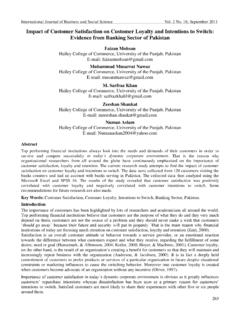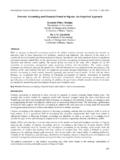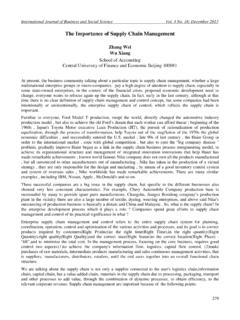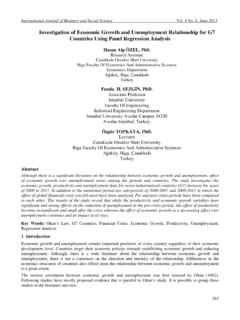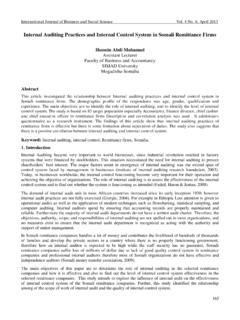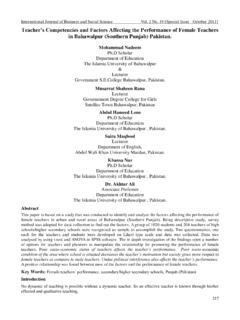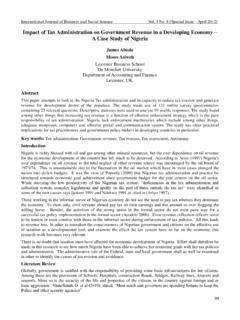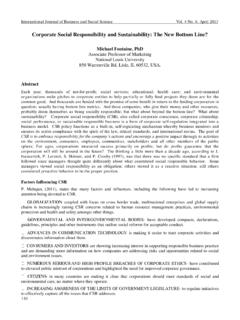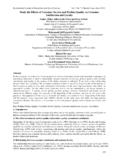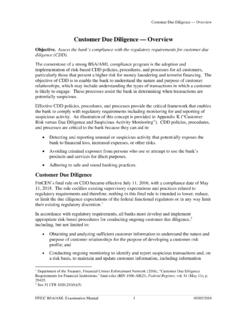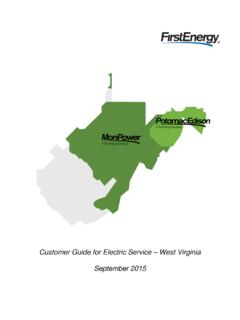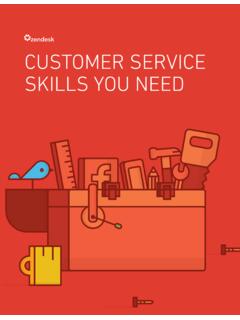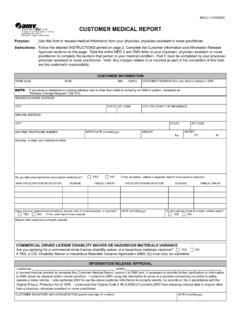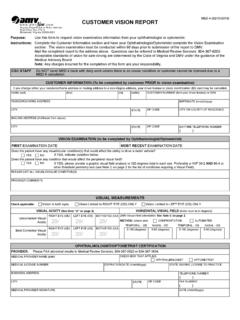Transcription of Customer Relationship Management
1 International Journal of Business and Social Science Vol. 2 No. 10; June 2011 166 Customer Relationship Management and Its Relationship to the Marketing Performance Dr. Hisham Sayed Soliman Lecturer Department of Business Management Faculty of Commerce Cairo University Abstract Purpose: This paper aims at exploring the theoretical foundations of Customer Relationship Management and its Relationship to the marketing performance from the several perspectives. Design/ methodology/approach : CRM was derived from systematic comparative analysis of the relevant Relationship marketing literature , there are additional elements that relating to the important of focus on main customers , the organizational efficiency and Customer knowledge Management elements and their influence on the marketing performance.
2 Findings: the study finings concluded positive Relationship between CRM and marketing performance. In additional to , being effect of the dimensions of CRM on marketing performance in financial institutions. Originality / value: the study treats the question of CRM and its Relationship marketing performance for marketing academicians and professionals by investigating structural Relationship among focus on main customers, the organizational efficiency and Customer knowledge Management , and marketing performance. Key Words: Customer Relationship Management (CRM) - Marketing Performance - Relationship Marketing 1. Introduction As a logical result of the appearance of the concept " Relationship Marketing" since the 1920s, the concept " Customer Relationship Management " (CRM) has been brought to attention in late nineties, especially among the academics and practitioners.
3 The new concept has directed the attention towards various vital aspects, including the necessity of direct Relationship between customers and marketers, the importance of keeping current customers, as well as the inevitability of building long-term relationships with customers instead of the Customer -oriented transaction method in order to augment the profitability of the institutions, especially in today's increasingly competitive economy (Ismail & et. al., 2007, ; Jayachandran & et. al., 2005, ) .Therefore, the organizations have directed their attention to CRM and abundant investing in the necessary infrastructure, with special concern to the great advance in Information Technology ( Ismail & et. al., 2007, ; Jayachandran & et. al . 2005, p. 177) Some considered, therefore, that improving the performance could be achieved through directing more attention to CRM (.)
4 Malmi & et . al., 2004, ). Now, CRM is considered one of the most important targets in about 60% of the projects around the world. Great advance in technology helped in better dividing of the market territories, enhancing communications with customers, providing an environment rich with information so as to contribute in improving efficient strategies to deal with customers. Possible to say that CRM systems would only have more future realization and understanding on the part of the beneficiaries if they were easy to use and carry out. In a modern study of De Paul University about the best practices of sales administration, only 50% of companies -of which sales reached more than one million dollars- admitted that they practice CRM, and only 55% of these companies made it clear that their CRM programs greatly helped establish relationships with customers.
5 While, 81% of the companies, which achieved sales of less than 100 million dollars and adopted ready-made CRM programs, admitted that these programs were useful; 75% mentioned that they helped establish Customer relationships. Generally speaking, the easier the system is, the stronger it can help establish Customer relationships. Accordingly, the future of CRM technology signals essential improvements in CRM systems, which would be able to improve electronic and direct marketing programs, enhance prediction models, improve planning systems of the project resources and change the framework and the organizational culture. Consequently, this will lead to better manage selling teams, enhance sales and increase the investment revenue rate in addition to helping users understand the advantages that they would gain.
6 In conclusion, achieving the above depends on the ability to simplify systems and provide time for users to learn be experienced and skilled in CRM ( Baran. 2008, 474-488). Centre for Promoting Ideas, USA 167 2. Theoretical Background of CRM Writers diverged in formulating a specific definition for CRM. This divergence may be owed to a difference in the scientific background of these writers. To begin with, (Swift, 2000 , 12-13)) defined CRM as a method of understanding the Customer behavior through intense communication with him/her to improve the performance which is represented in attracting the Customer , keeping him/her and increasing his/her loyalty and profitability. It can be noticed that this definition regards CRM as mere communication on the part of the organization to understand the Customer 's behavior.
7 (Stone & Findlay, 2001, p. 167) defined CRM as the organization carrying out a lot of information about the Customer from various resources and keeping it in order to divide the territories, analyze and reuse. This definition regards CRM as only collecting and recording information about the Customer . (Fross & Stone, 2001, ) defined CRM as the company use of its abilities in the field of research methodology, technology and e-commerce in order to manage Customer relationships. This definition for CRM regards it as the ability to use technology in the domain of dealing with customers.(Parvatiyar & Sheth , 2002, ) mentioned that CRM is a comprehensive strategy that includes the process of acquiring certain customers, keeping them and cooperating with them to create a distinguished value for both the company and the Customer .
8 This strategy requires integrating the functions of marketing, sales, Customer service and exposition chain so as to achieve the highest competence and efficiency in delivering value to the Customer . As it shows, this definition regards CRM as a strategy with a main goal of delivering a distinguished value to the Customer through improving the marketing productivity. On the other hand, (Payne & Frow, 2005, ) demonstrated that there are various points of view related to the concept of CRM. Whereas, some points of view were in favor of regarding CRM as correspondence in direct mail, a diagram for Customer loyalty programs or databases, other points of view regarded it as an assistant office work or a call center. Still, some considered it data storage or taking care of data search and processing.
9 Finally, some considered it gaining the systems that make it able to perform e-commerce . (Payne & Frow, 2005, ) mentioned that the obvious lack of accepted and appropriate definition of CRM may lead to the failure of the project of CRM, particularly if organizations adopt the limited point of view , which is related to specific technology (the technological dimension). Therefore, the two researchers tried to put a more comprehensive definition which pays attention to the strategic point of view . So they defined CRM as a strategic method related to creating a distinguished value for the contributors through improving good relationships with the main customers and other Customer categories, as it (CRM) seeks to unify the strategies of marketing using relationships and information technology to create profitable, long-term relationships with customers and other parties.
10 This value is created through providing good chances to use data and information to understand customers and provide them with value. Consequently, this requires the integration of customers, individuals and marketing abilities, which happens through information, technology and applications. (Kumar & Reinartz, 2006, ) agree with the above definition that CRM is merely a strategic process by which the institution's more profitable customers are chosen, and interactions between this institution and these customers is determined, in order to achieve the goal of maximizing the present and future values for customers. Unlike all the above, (Ramaseshan, 2006, ) defined CRM from the employment point of view as a process of achieving a continuous dialogue with each Customer on their own, using all the available means to know the quantitative expected response of that Customer as a result of practicing marketing activities to the degree that maximizes the general profitability of the It is clear that this definition only concerns about short-term CRM, and not long-term CRM.
